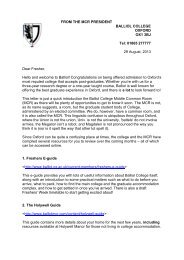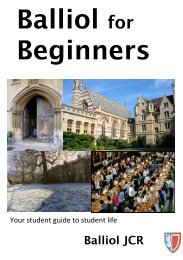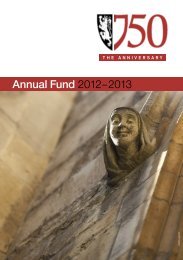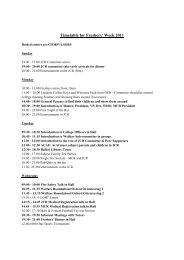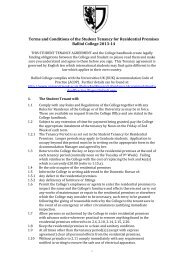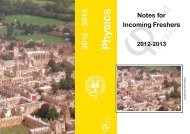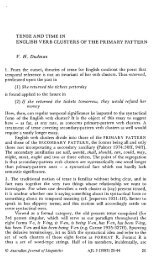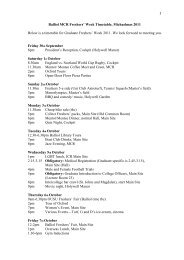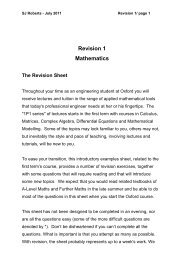CAAH Mods 2011 - Balliol College - University of Oxford
CAAH Mods 2011 - Balliol College - University of Oxford
CAAH Mods 2011 - Balliol College - University of Oxford
You also want an ePaper? Increase the reach of your titles
YUMPU automatically turns print PDFs into web optimized ePapers that Google loves.
you should flag the point at which your discussion begins to depend heavily on a published<br />
work, and the point(s) at which you introduce ideas or hypotheses derived from different<br />
published material. For example, you if you have a five-page discussion which is based on, or<br />
engages with, Source A, you should indicate this at the start <strong>of</strong>, and where appropriate, during,<br />
those five pages; it is misleading to cite Source A only at the end <strong>of</strong> the discussion based on<br />
it.<br />
In addition, it is not sufficient to simply to lift citations <strong>of</strong> relevant earlier literature from a recent<br />
discussion, and is a form <strong>of</strong> plagiarism to give the impression that you have read a number <strong>of</strong><br />
scholarly items when you have only lifted them from a footnote in the text you are using. You<br />
need to go and investigate them yourselves. Equally you should not cite publications unless<br />
you have read them. It is acceptable to refer the reader to the existence <strong>of</strong> older literature, or<br />
literature in a language other than English, which you have not read, as long as you make it<br />
clear that you have not read it (this can be denoted by saying 'not seen', or in Latin, 'non uidi').<br />
It is acceptable to say, for example, "the first significant discussion <strong>of</strong> the relationship between<br />
the consuls and the Senate was by Th. Mommsen (1887)"; but not to cite Mommsen's<br />
discussion as if you have read it, e.g. "the Senate was very much as an advisory body to the<br />
consuls (Mommsen 1887)".<br />
7. Example:<br />
This is a passage from P. Zanker, The Power <strong>of</strong> Images in the Age <strong>of</strong> Augustus (<strong>University</strong> <strong>of</strong><br />
Michigan Press, Ann Arbor 1988), pp. 210-11, discussing the sculptural programme in the<br />
Forum Augustum:<br />
‘But the most original and suggestive aspect <strong>of</strong> the whole program was that the counterpart to this Julian<br />
family portrait gallery, to the right <strong>of</strong> the temple, was a row <strong>of</strong> carefully selected great men <strong>of</strong> Rome<br />
(summi viri: Historia Augusta Alexander Severus 28.6). These stood beside Romulus and the kings <strong>of</strong><br />
Rome in the opposite colonnade. The juxtaposition <strong>of</strong> the two portrait galleries thus justified the position<br />
<strong>of</strong> the princeps’ family in the new Rome by proclaiming its unique historical importance. The reality <strong>of</strong><br />
competition between Rome’s leading families stretching back for centuries, all the ups and downs, and<br />
the relative insignificance <strong>of</strong> the Julii from the fourth to the second centuries B.C. were all thereby utterly<br />
obscured. In this version, the Julii had always been Rome’s most important family, for this family would<br />
produce her savior. A similar interpretation was already to be found in the poetry <strong>of</strong> Virgil.’<br />
A. Plagiarism:<br />
‘Augustus’ sculptural programme in his Forum is very interesting. Along the colonnade to the left <strong>of</strong> the<br />
temple were statues <strong>of</strong> Augustus’ ancestors, the Julian family. The most important aspect was that a row <strong>of</strong><br />
carefully selected great men (summi viri) were placed opposite the statues <strong>of</strong> the Julian family, in the<br />
colonnade to the right <strong>of</strong> the temple. Next to them were Romulus and the kings <strong>of</strong> Rome. This juxtaposition<br />
justified the position <strong>of</strong> the princeps’ family in the new order by proclaiming its unique historical importance.<br />
The line <strong>of</strong> statues <strong>of</strong> the Julian family made it look as though Augustus came from a line <strong>of</strong> important<br />
historical figures going right back to Aeneas, even though some <strong>of</strong> them had really been insignificant; they<br />
were instead equated with the great heroes <strong>of</strong> Roman history. Virgil’s poetry shows a similar view <strong>of</strong> history.’<br />
This version adds almost nothing to the original; it mixes direct appropriation with close<br />
paraphrase. There is no acknowledgement <strong>of</strong> the source; the writer suggests that the<br />
argument and the development <strong>of</strong> it is his or her own.<br />
B. Legitimate use <strong>of</strong> the passage:<br />
‘The sculptural programme in the Forum Augustum played an important part in Augustus’ self-projection<br />
aimed at legitimating his rule. At one end <strong>of</strong> the Forum stood the Temple <strong>of</strong> Mars Ultor; the flanking<br />
colonnades held lines <strong>of</strong> statues and the exedrae within them contained statues <strong>of</strong> Romulus and Remus to<br />
the right <strong>of</strong> the temple, and Aeneas and Ascanius/Iulus to the left. Zanker points out that the juxtaposition <strong>of</strong><br />
the ancestors <strong>of</strong> the gens Iulia on the left side and the line <strong>of</strong> Rome’s past heroes or summi viri on the right<br />
39



